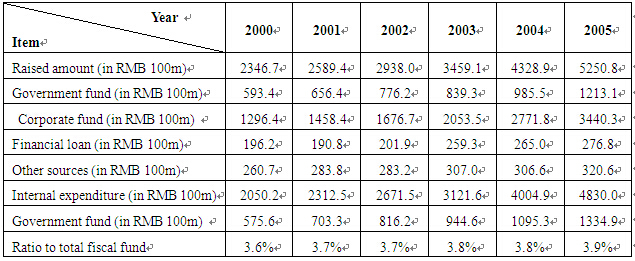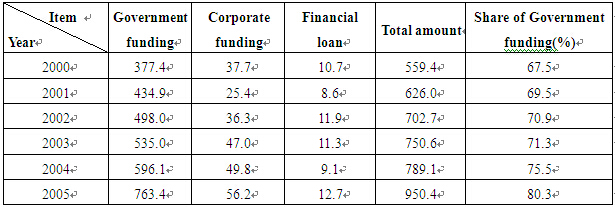Distribution and Management of Government Fundfor Science and Technology Activities
Jul 18,2007
By Shen Hengchao, Department of Techno-Economics Research of DRC
Research Report No. 252, 2007
The fund for science and technology (S&T) activities refers to the money raised for S&T services, research and development (R&D), research result application and other activities or refers to the actual spending on these activities.
Government fund for S&T activities not only accounts for a major part of the total S&T fund, but also can guide and stimulate other inputs into S&T activities. Therefore, it is necessary to study the distribution and use of the government fund for S&T activities so as to increase its efficiency.
I. Scale and Structure of China's Government Fund for S&T Activities
1. Scale
In the prevalent statistical work, the source and spending of the fund for S&T activities can be represented by two indicators respectively, namely funding for and internal expenditure on S&T activities.
As Table 1 indicates, China's fund for S&T activities has been growing rapidly in recent years. The funding in 2005 totaled RMB 525.08 billion yuan, more than doubling that in 2000. The internal expenditures in 2005 reached RMB 483 billion yuan, or 2.4 times that in 2000. Of the total of funding, government fund accounted for about one-fourth. But the ratio has declined somewhat in the past two years. In 2005, government fund was RMB 121.31 billion yuan, accounting for 23.1%. Of the internal expenditure, government fund accounted for more than one-fourth. Despite a slight drop in recent years, the absolute amount has been rising steadily, maintaining a fairly stable ratio with the country's total fiscal expenditure.
2. Structure
(1) Classification according to purposes
Based on different purposes, government fund for S&T activities can be classified into S&T expense, three kinds of fees for S&T activities, infrastructure construction fees, and others.
a. S&T expense. It comprises operating expenses and project spending, which refer mainly to the recurrent operational and administrative expenses of the research institutions under the departments of the central government and the laboratories of some universities and also the project spending used for both basic and applied research projects. In 2005, S&T expense accounted for 30% of the total government fund for S&T activities.
Table 1 Funding for and Internal Expenditures on S&T Activities

Source: China Statistical Yearbook 2006, Statistical Data about S&T Activities 2006, and China S&T Activities Statistical Yearbook 2006.
b. Three kinds of fees for S&T activities. They refer to product experiment fee, intermediate experiment fee and major research project subsidy. Mainly used to support national key S&T projects, they are allocated by relevant supervision agencies to the undertaking units of specific S&T projects. In 2005, the three fees accounted for about 40% of the total government fund for S&T activities.
c. Infrastructure construction fees for S&T activities. They refer to the national fiscal expenditure on infrastructure construction in S&T activities and consist of two parts. One is the construction spending of national key laboratories, national research centers on engineering technology, national engineering research centers, large-scale science facilities and basic facilities for science popularization. The other is the expense on building facilities of research institutions and on research projects of infrastructure construction nature. Currently, infrastructure construction fees for S&T activities are listed in the “spending on scientific infrastructure construction” under the heading of “spending on infrastructure construction” in the fiscal account. In 2005, they accounted for about 12% of the total government fund for S&T activities.
d. Others. They refer to the spending on S&T activities from the funds earmarked for education, healthcare and agriculture. In 2005, they accounted for about 18 percent of the total government fund for S&T activities.
(2) Classification according to implementing bodies
Based on different implementing bodies, the government fund for S&T activities is classified into the fund spent by research institutions, by institutions of higher learning and by enterprises.
a. Government fund spent by research institutions. Table 2 indicates that the share of government funding in the total fund on S&T activities spent by research institutions has been continuously rising. In 2005, the share was over 80% and the absolute amount was RMB 76.34 billion yuan, which was more than twice as much as in 2000.
Table 2 Funding for S&T Activities Raised by R&D Institutions (in RMB 100m)

Source: China Statistical Yearbook 2006. The coverage of statistics includes research institutions, institutions of science and technology information and literature, institutions with independent accounting system at and above county level, excluding the research institutions which are not covered by state budget.
b. Government fund for S&T activities spent by institutions of higher education. Table 3 indicates that the share of government funding in the total fund for S&T activities spent by institutions of higher education has been basically stable, at about 55%. In 2005, the share was 54.6% and the absolute amount was was RMB 25.15 billion yuan.
Table 3 Funding for S&T Activities Raised by Institutions of Higher Education (in RMB 100m)

Source: China Statistical Yearbook 2006.
c. Government fund for S&T activities spent by enterprises. Table 4 indicates that government funding accounted for only less than 5% of the total fund for S&T activities raised by enterprises. The continuously declining share was 3.1% in 2005 and the absolute amount was RMB 8.19 billion.
Table 4 Funding for S&T Activities Raised by Large and Medium-Sized Enterprises (in RMB 100m)

Source: China Statistical Yearbook 2006.
...
If you need the full context, please leave a message on the website.














